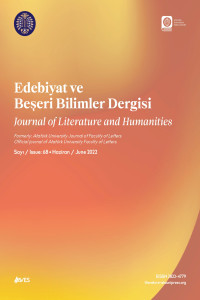KRİZ YÖNETİMİ SİSTEMİNİN VERİMLİLİĞİNİN YAPISAL EŞİTLİK MODELİYLE DEĞERLENDİRİLMESİ / Evaluation Of The Efficiency Of The Crisis Management System With The Structural Equation Modeling
ÖzAcil durumlarda ortaya çıkanzararların ve can kayıplarının önünegeçilmesini amaçlayan kriz yönetimipolitikaları kamu yönetiminde çok önemli biryere sahiptir. Kurumsal ağların verimliliğiölçülerek bir sonraki acil durumda daha kalitelibir kriz yönetimi sağlayacak çözümlerüretilebilir. Kriz yönetimi uzun bir süreçolduğu için kısa zamanda belli bir ağınverimliliğini ölçmek adına terörist saldırılardaoluşan kriz yönetimi ağları kullanılabilir.Araştırmada 2003’te İstanbul’da yaşananterörist saldırılarındaki kriz yönetimi faaliyetleritemel alınarak bu verimliliği tanımlamak adınaçeşitli faktörler kullanılmış ve çok yönlükorelasyonlar irdelenmiştir. Kullanılanistatistiksel metodun grafiksel anlatımıyla hemnitel hem de nicel varsayımlar başarıyla testedilerek kriz yönetimi örgütlerinin öncelikliolarak uygulaması gereken teknikler tavsiyeedilmiştir. Bu tekniklerin başında genel krizyönetimi işlevlerini yürütebilme, gönüllü vesabit kuruluşların başarılı koordinasyonu vekriz yönetimi faaliyeti öncesinde farklı kurumçalışanları arasında gelişmiş bulunan gayriresmiilişkiler gelmektedir.Anahtar Kelimeler: Kriz yönetimi, yapısal eşitlik modeli, ağ verimliliğiAbstractPreventing losses and casualties duringemergencies, crisis management policies holdan important place in public administration.Solutions can be introduced by measuringnetwork efficiency to provide a better quality ofcrisis management for the next emergency.Since crisis management actually takes a longtime to evaluate and analysis thoroughly,terrorist attacks can be utilized in order tocalculate the efficiency of a crisis managementnetwork in a considerably shorter time.Research explored versatile correlations amongseveral factors identifying the crisismanagement efficiency based on activities inthe 2003 Istanbul attacks. Graphicalrepresentation of the utilized statistical methodtested both qualitative and quantitativeassumptions and recommended techniquesshould primarily be implemented by crisismanagement organizations. Some of thosetechniques are running and acknowledginggeneric crisis management agents, a reliablecoordination between voluntary and stateorganizations, and informal relationshipsamong the individual employees of differentorganizations developed before the incidents.Keywords: Crisis management, structural equation modeling, network effectiveness.
Anahtar Kelimeler:
Kriz yönetimi, yapısal eşitlik modeli
___
- ALEXANDER, D. (2005). Towards the development of a standard in emergency planning, Disaster Prevention and Management, 14(2), 158 – 175.
- ARBUCKLE, J. L. (2014). Amos (Version 22.0) [Computer Program]. Chicago: SPSS. Aykaç, B. (2001), Kamu yönetiminde kriz ve kriz yönetimi. İktisadi ve İdari Bilimler Fakültesi Dergisi, 3 (2), 1-9.
- BİRKLAND. T.A. (2006). Lessons of disaster: policy change after catastrophic events , Georgetown University Press, Washington DC.
- BOİN, A. ve McConnell, A. (2007), Preparing for critical infrastructure breakdowns: the limits of crisis management and the need for resilience.Journal of Contingencies and Crisis Management, 15 (1), 50-59.
- BOİN, A., Jacobs, B., ve Comfort, L. K. (2012). Mega-crises: understanding the prospects, nature, characteristics, and the effects of cataclysmic events. Washington DC: Charles Thomas.
- BYRNE, B.M. (2013). Structural equation modeling with AMOS: Basic concepts, applications, and programming. New Jersey: Routledge.
- COMFORT, L. K. (2005). Risk, Security, and Disaster Management. Annual Review of Political Science, 8 (1), 335-356.
- FARAZMAND, A. (2007). Learning from the Katrina Crisis: A Global and International Perspective with Implications for Future Crisis Management, Public Administration Review, 67 (5), 149-159.
- İSBİR, E. G. ve Genç, F. N. (2008). The Role of International Organizations in Disaster Response: The 1999 Marmara Earthquake Case. Amme İdaresi Dergisi, 41 (3), 73- 97.
- KRACKHARDT, D. ve R. N. Stern (1988). Informal Networks and Organizational Crises: An Experimental Simulation. Social Psychology Quarterly, 51 (2), 123-140.
- MCENTİRE DA. ve Myers A. (2004). Preparing communities for disasters: issues and processes for government readiness, Disaster Prevention and Management, 13 (2).
- Yayın Aralığı: Yılda 2 Sayı
- Başlangıç: 1970
- Yayıncı: Atatürk Üniversitesi
